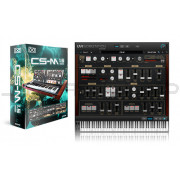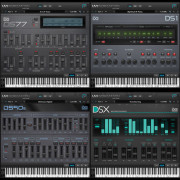You're currently on:
Download License! Email Delivery!
A comprehensive collection of sounds from 80 classic drum machines from the 70s, 80s, and early 90s spanning over 10,000 sounds and loops.
Beat Box Anthology is the one-stop shopping collection for drum machine sounds and loops, covering almost every generation of these instruments. Even if these cult machines were a milestone in the 70s, 80s and 90s music production, their sounds are still used today in a lot of Urban, Hip Hop, Electro House and even Electro Pop productions.
The first "affordable" drum machines were manufactured in the 60s, and were designed to imitate the sounds of drums and percussions. Analog synthesis was the the first technology used to generate the drum sounds and most models left no opportunity to the user to alter or modify the pre-programmed rhythms. Then in the 80s the first models using low resolution digital samples were launched, and were quickly used in the most successful tunes in the music industry. In the 90s the sound quality turned better, but loosing in the meantime the character that had made older models so remarkable. That's where and why our investigation stopped.
Beat Box Anthology is divided in three sections: Classics, Analog & Digital. In the Classics category you will find the cult machines that are still used a lot today, like the 808 or the 909. Sampling and recording was particularly complete, covering every parameter and setting you can find on these machines. To capture the essence of these pieces of history, we did record everything in 24bit 96kHz, using the best DI Box and analog to digital converters.
Another unique approach to this kind of collection, is the mastering step that once more makes it unique. Sounds were mastered at Sterling Sound with Chris Gerhinger, for this punchy sound you won't find anywhere else.
With a total of around 10 000 samples and loops from 80 different machines, Beat Box Anthology also contains hundreds of native kits and patterns for the new MOTU BPM, then being its best companion. Whatever the kind of music you're making, you will certainly find room for these incredible sounding machines.
Machines used to create the sounds:
Acetone Rhythm Ace FR-1, FR-2L, FR-6 & FR-8 / Akai XR-10 / Alesis HR-16, HR-16b & DPM5 / Amdek Rhythm Machine RMK-100 / Bohm Digital Drums M. / Boss DR-110 Dr. Rhythm, DR-220 A, DR-220 E & DRP-I Dr. Pad / Casio RZ-1 / Crumar OMB-2 / Dynacord Add One / Elka Drumstar 80, OMB 5, Wilgamat / E-mu Drumulator / ETI Drum Synthesizer / Godwin Drummaker 45 / Hohner Drum Performer & Rhythm 80 / Kawai R-100 / Korg DDD-1, DDM-100, DDM-220, KPR 77, KR33, KR55, MR16 & S3 / Linn 9000 & Linn Drum / Mattel Synsonic Drums / Mini Pops Junior Keio / MPC the Kit / Novation Drumstation / Oberheim DMX / Pearl Drum-X & Fightman/ Realistic Rhythm Box Concert Mate / Roland CR-78, CR-8000, TR-505, TR-55, TR-606, TR-626, TR-66, TR-707, TR-727, TR-77, TR-808 & TR-909 / SCI Drumtracks/ Siel MDP40 / Simmons Clap Trap, MTX-9, SDS 400, SDS 800, SDS 9, SDSV & Trixer / Solton Arranger + / Tama Techstar TAM500, DS200 & Techstar TS204 / Ted Digisound Synth / Univox ARI / Vermona / Wersi Drum Composer / Wersi Wersimatic WM24 / Yamaha DD-10, MR10, QY10, RX5, RX7 & RX8
Why 24bits / 96 kHz?
In the mess of technical figures, it's sometimes difficult to be realistic, so let's be honest. A few years ago, we started to record all our new sounds in 24/192 resolution, thinking that it was the best solution of all. In a way it is, but after tons of testing and comparing, we did choose the 24/96 format for two main reasons:
1- Although one can hear the difference between 16/44.1 and 24/96, even experts can't tell the difference between 24/96 and 24/192.
2- And to be honest, 24/192KHz is still too heavy to use with current computers and harddrives, even with the new productive UVI Engine.
| Variant | N/A |




















